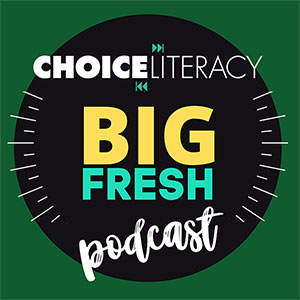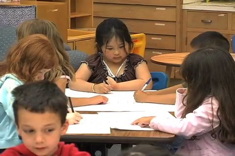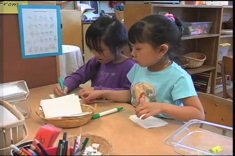
Franki Sibberson: Kate, can you talk a little bit about the premise of your work around revision? What are the most important things for teachers of writing to understand about revision?
Kate Messner: Well, I think the biggest thing is that it is a process. We talk about teaching the revision process and to be perfectly honest with you, it wasn’t until I really started writing for publication that I had a full sense of what that was.
And that’s kind of what led to my book with Stenhouse, Real Revision: Authors’ Strategies to Share with Student Writers. I as a 7th grade English teacher have always brought my drafts and my editorial letters and my very messy, marked-up manuscripts into the classroom because I think it’s really useful to model that process for kids. When you’re asking a kid to maybe rewrite the first paragraph of an essay or something, if you can pull out a manuscript and say, “Well, I trashed this first chapter and rewrote this one and then I changed it around,” you gain an awful lot of credibility there.
And also kids get a sense that this is not a one quick draft situation. So much of our writing right now is focused toward tests and that one draft sort of writing I think has changed the way we teach a little bit and I love to see teachers who are getting back to writing as a real process and including time to think in that. I think that’s really, really important that you can’t revise, take another look at something until you’ve had a little time to look away.
Franki Sibberson: That’s smart. And so you’ve published such a variety of texts. You’ve done picture books, novels, professional books. You teach full time. How does your own writing process inform your teaching? You talked a little bit about the modeling but how does your process inform your actual teaching?
Kate Messner: I think for one thing it’s given me a lot of empathy for students because, as somebody who always loved English, writing came pretty easily to me and honestly it wasn’t until I started writing a lot more seriously for publication that I really did end up trashing a whole draft or deleting a whole chapter and starting over or really making those substantive changes to a piece of writing.
So, I think it gave me a lot of empathy for students but it also gave me a sense for the fun of revision and the joy of really crafting something and having that time. And it was really something I wanted my students to experience so a lot of the strategies that I use as a writer, returning to the brainstorming process, returning to the planning process during revision, returning to research, are strategies that I encourage my students to use, too.
Franki Sibberson: That’s so smart. So, you interviewed over 40 children’s authors about their revision process in your book. Why did you think it was – I mean that was such a huge piece of the book, too, and what I learned from it, but why did you think it was important to share such a variety of different authors’ processes?
Kate Messner: Pure selfishness. I’m nosy and I wanted to know what everybody was doing.
Franki Sibberson: I love it.
Kate Messner: In all honesty, this book was the greatest book to work on because it was such an education for me. I’ve always been one of those writers who loves to hear about other people’s processes. When I was working on my first novel, I was scouring the Internet looking for blog posts from authors about how do they revise. What do they do? Where do they start?
And that information some authors do share that so generously online. It was so helpful to me that I couldn’t help later on thinking what if we put this all out there for teachers and writers and students and just kind of pulled back the curtain with the Wizard of Oz and said, “Here’s how it’s done. Here’s what’s really happening behind that curtain or that shiny book jacket as the case may be.”
And I think the variety was important because we ask our students to write a lot of different things and the revision process for a three verse poem, for example, is going to look very different from the revision process for a straightforward, persuasive essay. And that’s gonna look very different from the revision process for the beginning of a novel that a student works on or a short story or anything like that. And even within genres, there are so many different ways to approach it.
And again, I think with the standardized testing we sometimes get caught up in that one right answer situation and with revision there’s not one right answer. There are a lot of different ways you can approach a manuscript. A lot of different things you can do first, a lot of different strategies that you can use. And they’re all effective.
So I thought including that really wide variety of authors and that wide variety of strategies would kind of give kids a pretty big toolbox from which to choose.
Franki Sibberson: I love that and there are authors that they’ll know, too, so that’s fun. So, what did you learn from your interviews that either impacted your own teaching or your own writing? Any tips?
Kate Messner: I immediately when I started researching this book started implementing a lot of those activities in my classroom. I was teaching an advanced creative writing class at the time and we sat right down I think the weekend after Wendy Mass sent in her revision notes and tried out her character generating worksheet. She has a whole worksheet that she uses when she’s coming up with new characters, and the kids loved that.
So, really, all the ideas that came in I tested in the classroom when I was developing the classroom activities. Each mentor author interview also comes with a try it section so it’s a section where it kind of takes the author’s strategy and boils it down to the student level and says, “Here’s how you can use this in your own work and classroom writing.” And some of those are longer activities that might take a full period or students might work on over the course of a week but some of them are really short, five or ten-minute activities, too, and I think that can be useful because in a perfect world we would have unlimited time for revision but we all know that in the classroom that’s not necessarily the case.
Franki Sibberson: So how can teachers feel more comfortable with revision work? And when I think about one of the issues, too, is time, time to really give kids not just comfortable with the process but also comfortable with the time it takes to really revise. Do you have any suggestions on that for how do you do it?
Kate Messner: Well, I think one thing that’s important to get across to students and to teachers, too, first is that there are different kinds of writing. When I sit down to answer an email I’m not doing five or six drafts. I’m doing one draft of the email, taking a quick look at it, and sending it.
And there are lots of kinds of writing in our lives that are quick, one draft kinds of writing and our kids know this already. They certainly don’t do multiple drafts of every text that they send on their phone. But at the same time I think it’s really important to have, even if it’s just one piece of writing per quarter or one piece per semester, that really goes through that deep, thoughtful process of revision because otherwise I don’t think kids really get to experience the joy of writing something that’s special and that’s different from that quick test writing.
And I think that’s sometimes where we lose our writers, in this idea that everything gets written and turned in and written and turned in and kids don’t get to experience the hard work, first of all, of going back and looking at something a different way and trying something from a different angle. But also the joy of discovering new possibilities.
So, I think if there’s just one piece each quarter that you can say, “Okay, this is the one that we’re really gonna focus on process.” And have kids do a draft and put it away for a while and then take it back out. And it doesn’t have to swallow the whole quarter. It can be an on and off sort of thing.
That’s something that authors do all the time. We finish a draft. We put it away for a while. We look at it, we revise it. Maybe we send it off to a critique partner to read. They send it back and we do a new draft and then we send it to our editor and our editor reads through it and makes notes for a couple months.
So, these manuscripts of ours, they go away on vacation for a while and we don’t see them and then they come back and I think that’s a healthy thing for students to try, too.
Franki Sibberson: You keep mentioning the joy in revision. Do you have any quick things that we can do as teachers to really help students enjoy that revision process rather than dread it?
Kate Messner: I think one big thing is giving kids a heads up that their draft is not their final draft. Once students know that they are going to be working on a piece for a long time, and if you approach it and you say, you know, “Today we’re gonna do a really rough brainstorming piece or a really quick rough poem and then we’re really gonna work hard on revision,” then they know that going in.
But, again, I think a lot of kids are conditioned to this test writing and so they think, “I am going to finish it and turn it in when it’s done. So, I think in a lot of cases it’s just knowing that up front so you’re not doing a final draft today.
Very often we go to the computer lab and I say, “Nobody’s gonna print for three weeks. Just don’t even worry about it. Nobody’s even gonna spell check for three weeks. Don’t worry about it. We’re gonna focus on the big picture things for a while.”
Then the kids know up front they can kind of relax, knowing that this paper isn’t due the next day and then you can introduce some really fun revision activities. There’s a lot in the book about using colored pencils to color code and using sticky notes. I think personally I should own stock in the Post-It company. I love my sticky notes. A lot of those activities are really fun if there’s time for them.







